Ermine Street: Difference between revisions
Created page with "{{distinguish|Ermin Street}} right|thumb|250px|Map showing Ermine Street '''Ermine Street''' is the name of a major Roman road that ran 193 mile..." |
No edit summary |
||
| Line 1: | Line 1: | ||
{{distinguish|Ermin Street}} | {{distinguish|Ermin Street}} | ||
[[File:Ermine Street. | [[File:Roman Roads in Britannia.svg|right|thumb|250px|Roman roads: Ermine Street in red]] | ||
[[File:Ermine Street near Cranwell - geograph.org.uk - 496481.jpg|right|thumb|250px|Ermine Street as a path near Cranwell]] | |||
'''Ermine Street''' is the name of a major [[Roman road]] that ran 193 miles from [[London]] (''Londinium'') to [[Lincoln]] (''[[Lindum Colonia]]'') and to [[York]] (''Eboracum''). | '''Ermine Street''' is the name of a major [[Roman road]] that ran 193 miles from [[London]] (''Londinium'') to [[Lincoln]] (''[[Lindum Colonia]]'') and to [[York]] (''Eboracum''). | ||
| Line 7: | Line 8: | ||
==The course of Ermine Street== | ==The course of Ermine Street== | ||
===Middlesex and Hertfordshire=== | ===Middlesex and Hertfordshire=== | ||
[[File:Stoke Newington High Street, N16 - geograph.org.uk - 391252.jpg|right|thumb|200px|Stoke Newington High Street]] | |||
Ermine Street begins at London, at Bishopsgate, where one of the seven gates in the wall surrounding Roman London was located. From here it runs north up through [[Middlesex]], through [[Norton Folgate]], [[Shoreditch]] High Street and Kingsland Road. It runs through [[Stoke Newington]] as Stoke Newington High Street, then through [[Tottenham]], [[Edmonton]] and to the east of [[Enfield]]. | Ermine Street begins at London, at Bishopsgate, where one of the seven gates in the wall surrounding Roman London was located. From here it runs north up through [[Middlesex]], through [[Norton Folgate]], [[Shoreditch]] High Street and Kingsland Road. It runs through [[Stoke Newington]] as Stoke Newington High Street, then through [[Tottenham]], [[Edmonton]] and to the east of [[Enfield]]. | ||
| Line 12: | Line 14: | ||
===Cambridgeshire to Rutland=== | ===Cambridgeshire to Rutland=== | ||
[[File:A1198 Ermine Street South, Papworth Everard - geograph.org.uk - 1084562.jpg|right|thumb|200px|North of Caxton Gibbet]] | |||
[[File:Ermine Street - geograph.org.uk - 204132.jpg|right|thumb|200px|Ermine Street Burghley Park]] | |||
At the Icknield Way, Ermine Street enters Cambridgeshire. From here the road was formerly the A14 to the A1 but is now it is the A1198. It heads north-northwest through the southwest of the county, through [[Caxton Gibbet]] to [[Papworth Everard]] and enters [[Huntingdonshire]]. The road continues to [[Godmanchester]] (''Durovigutum''), where Godmanchester's distinctive Anglo-Saxon pentagonal town centre sits on top of the original route. Ignoring bypasses and modern diversions, the road through [[Huntingdon]] and [[the Stukeleys]] to the Alconbury junction on the A1 gives the line. The section from [[Alconbury]] to [[Water Newton]], ignoring modern bypasses such as that at [[Stilton]], follows the A1. | At the Icknield Way, Ermine Street enters Cambridgeshire. From here the road was formerly the A14 to the A1 but is now it is the A1198. It heads north-northwest through the southwest of the county, through [[Caxton Gibbet]] to [[Papworth Everard]] and enters [[Huntingdonshire]]. The road continues to [[Godmanchester]] (''Durovigutum''), where Godmanchester's distinctive Anglo-Saxon pentagonal town centre sits on top of the original route. Ignoring bypasses and modern diversions, the road through [[Huntingdon]] and [[the Stukeleys]] to the Alconbury junction on the A1 gives the line. The section from [[Alconbury]] to [[Water Newton]], ignoring modern bypasses such as that at [[Stilton]], follows the A1. | ||
Latest revision as of 20:15, 27 October 2014
- Not to be confused with Ermin Street
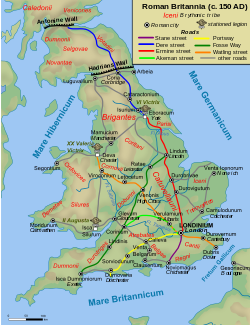
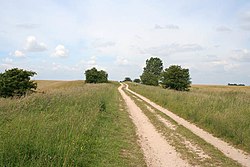
Ermine Street is the name of a major Roman road that ran 193 miles from London (Londinium) to Lincoln (Lindum Colonia) and to York (Eboracum).
The Old English name for this road was "Earninga Straete" (1012), named apparently after a clan called the Earningas, who inhabited a district later known as Armingford Hundred, around Arrington in Cambridgeshire and Royston, Hertfordshire. "Armingford", and "Arrington" share the same Old English origin. The original Roman name for the route is unknown. It is also known as the Old North Road from London to where it joins the A1 Great North Road near Godmanchester in Huntingdonshire.
The course of Ermine Street
Middlesex and Hertfordshire
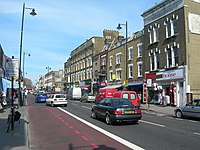
Ermine Street begins at London, at Bishopsgate, where one of the seven gates in the wall surrounding Roman London was located. From here it runs north up through Middlesex, through Norton Folgate, Shoreditch High Street and Kingsland Road. It runs through Stoke Newington as Stoke Newington High Street, then through Tottenham, Edmonton and to the east of Enfield.
North of Enfield the route enters Hertfordshire and is followed by the A10 to Royston on the border of Hertfordshire with Cambridgeshire. The A10 diverges here but the old route forms Royston High Street. Here it meets the Icknield Way in the middle of the town.
Cambridgeshire to Rutland
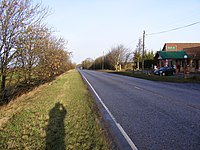
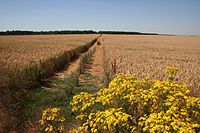
At the Icknield Way, Ermine Street enters Cambridgeshire. From here the road was formerly the A14 to the A1 but is now it is the A1198. It heads north-northwest through the southwest of the county, through Caxton Gibbet to Papworth Everard and enters Huntingdonshire. The road continues to Godmanchester (Durovigutum), where Godmanchester's distinctive Anglo-Saxon pentagonal town centre sits on top of the original route. Ignoring bypasses and modern diversions, the road through Huntingdon and the Stukeleys to the Alconbury junction on the A1 gives the line. The section from Alconbury to Water Newton, ignoring modern bypasses such as that at Stilton, follows the A1.
Ermine Street turns more northwesterly. It used to pass through Durobrivae, a Roman town the slight remains of which can be seen to the east, alongside the A1 at Peterborough. (The place was until recent centuries known as Dogthorpe.) Here the line of the road crosses the River Nene into Northamptonshire, no longer followed by a modern road.
Through the Soke of Peterborough, Ermine Street is generally just a line on the map, occasionally overlaid with a minor road for a few hundred yards, then marked by a footpath from near Barnack to Burghley Park. Shortly therafter the route crosses the River Welland into Lincolnshire at Stamford; any past bridge has long been lost. Soon past Stamford the road enters Rutland.
The modern road returns to Ermine Street northwest of Stamford, near Great Casterton in Rutland, through which Ermine Street ran and where a Roman town once stood. Soon afterwards it turns north and having done with Rutland it re-enters Lincolnshire.
Lincolnshire
The post-Roman road wandered off for two and half miles through Colsterworth, but Ermine Street continues as the B6403, through Ancaster to the A17. It then continues as a public right of way, easily walked, until Waddington airfield blocks it at SK981626. The route from Colsterworth, through Ancaster, to Bracebridge Heath is known as High Dike. It runs roughly parallel with and to the east of the A607 between Carlton Scroop and Harmston. High Dike takes to the level, open, dry country of the Lincolnshire Heath while the A607 wanders through the villages on the spring line below. From the Antonine Itinerary there is known to have been a Roman settlement on the road in South Lincolnshire, called Causennae which has been variously identified with Ancaster Roman Town or Saltersford, south of Grantham.[1][2][3]
Another long section remains, now the A15, running north out of Lincoln, past RAF Scampton and Caenby Corner, as far as Kirton in Lindsey at grid reference SE9698. It then continues almost to the Humber at Winteringham. Before the diversion was made round the extended runway at Scampton, with a very slight diversion at Broughton, it was possible to travel about 33 miles, from the Newport Arch, the Roman north gate at Lincoln, to the Parish of Winteringham along a road so slightly curved as to be regarded as straight. This may possibly have been the longest single section of straight road in Britain.
Terminus
Roman Winteringham was the terminal for the ferry to Petuaria (Brough) on the north shore of the Humber. From there, the road curved westwards to York.
This landing place on the south shore of the Humber is significant because Winteringham translates as "the homestead of Winta's people": Winta is the name of the first king of Lindsey according to the king list for the Lindisware (apart from legendary forebears such as Woden.
The alternative course of Ermine Street
There is a sector of Ermine Street in which there was an alternative route. As Ermine Street extended north out of Lincoln and past Scampton the map attached clearly shows an alternative course of Ermine Street curving left and forming a semicircle on a wide heading west of the Humber. Whilst the straight northerly route, traced in red on the map, between Lincoln and York was the shorter, this route was not always passable over the Humber during adverse weather conditions. Thus a significantly important alternative route was established.
This 'alternative' route is detailed in the Antonine Itinerary and linked York (Eboracum), Castleford (Lagecium), Doncaster (Danum), Littleborough (Agelocum) and Lincoln (Lindum). Beginning at the modern Lincolnshire Showground the portion of this route in Lincolnshire is known as Till Bridge Lane, the modern A1500. The route in the Doncaster area, and again north of Castleford, is known as the Roman Ridge or Roman Rigg.
A large section of this road formed what for many later centuries became the Great North Road between Nottinghamshire and the West Riding of Yorkshire.
Outside links
| ("Wikimedia Commons" has material about Ermine Street) |
References
- ↑ National Monuments Record: No. 325760
- ↑ Whitewell, J.B. (1970). Roman Lincolnshire. History of Lincolnshire. 2. Lincolnshire local history society. pp. 64, 65.
- ↑ Margary, Ivan D. (1967). Roman Roads in Britain. London: John Baker.
- I. D. Margary, Roman Roads in Britain (3rd ed. 1973)
- Ordnance Survey 1:50 000 maps. (1972 to 2001)
- Ordnance Survey, Map of Roman Britain (3rd edn. 1956)
- Soil Survey of England And Wales, Soils of England and Wales , Sheet 4 (1983)
Coordinates: 53°09′05″N 0°32′04″W / 53.15151°N 0.53454°W
